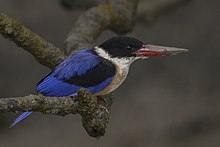Black-capped kingfisher
| Black-capped kingfisher | |
|---|---|

| |
| An adult Black-capped Kingfisher from Sundarban, West Bengal, India. | |
| Scientific classification | |
| Kingdom: | |
| Phylum: | |
| Class: | |
| Order: | |
| Family: | |
| Genus: | |
| Species: | H. pileata
|
| Binomial name | |
| Halcyon pileata (Boddaert, 1783)
| |
The black-capped kingfisher (Halcyon pileata) is a tree kingfisher which is widely distributed in tropical Asia from India east to China, Korea and Southeast Asia. This most northerly of the Halcyonidae is resident over much of its range, but northern populations are migratory and they wintering south of their range to Sri Lanka, Thailand, Borneo and Java. It is distinctive in having a black cap that contrasts with the whitish throat, purple blue wings and the coral red bill. The species is mainly found in coastal and mangrove habitats but can sometimes be found far inland.
Description

This kingfisher is about 28 centimetres (11 in) long. The adult has a purple-blue wings and back, black head and shoulders, white neck collar and throat, and rufous underparts. The large bill and legs are bright red. In flight, large white patches or "mirrors" at the base of the primaries are visible on the blue and black wings. Sexes are similar, but juveniles are a duller version of the adult and show streaks on the throat.[2] The call of this kingfisher is a cackling ki-ki-ki-ki-ki.
Usually seen on coastal waters and especially in mangroves, it is easily disturbed, but perches conspicuously and dives to catch fish but also feeds on large insects. The flight of the black-capped kingfisher is rapid and direct, the short rounded wings whirring.
The breeding season is in summer. The nest is a tunnel in an earth bank. A single clutch of 4-5 round white eggs is typical.[2]
A subspecies palawanensis has been described but the species is considered to be monotypic with no clear plumage differences across their range.[3]
Distribution and habitat
The species is found mainly near the coast in mangrove forests and along estuaries and rivers. The distribution ranges from India (including the Andaman and Nicobar Islands where they occur even on remote islands like Narcondam[4]), Sri Lanka, Kansu, Shansi, Korea, Malay Peninsula, Thailand, Burma,[5] Ryu kyu Islands, Hainan, Philippines (Palawan, Balabac, Basilan, Tawi Tawi), Borneo, Sumatra east to Sulawesi where it occurs only in winter.[3] Vagrants in winter have been recorded in Pakistan[6] while movements related to rainfall may lead to their being found far inland and away from their usual distribution.[7][8][9][10][11]
In culture
Like many other kingfishers, this species was much sought for the blue feathers for their use in the millinery trade. Feathers were used in making fans in China.[11] In Hong Kong, their feathers were cut and glued over ornaments used by women.[12]
References
- ^ Template:IUCN
- ^ a b Baker, E.C. Stuart. The Fauna of British India including Ceylon and Burma. Birds. Volume IV (2 ed.). London: Taylor and Francis. pp. 271–272.
- ^ a b Peters, James Lee (1945). Check-list of the birds of the world. Volume V. Cambridge, MA: Harvard University Press. p. 197.
- ^ Osmaston, B.B (1905). "A visit to Narcondam". J. Bombay Nat. Hist. Soc. 16 (4): 620–622.
- ^ Oates, E.W. (1883). A handbook to the birds of British Burmah. Volume 2. London: R.H. Porter. p. 83.
- ^ Kylanpaa, Juha (1998). "Black-capped Kingfisher Halcyon pileata: a new species for Pakistan" (PDF). Forktail. 13: 126.
- ^ Stevens, H (1904). "The occurrence of the Black-capped Kingfisher Halcyon pileata in North Lakhimpur, Upper Assam". J. Bombay Nat. Hist. Soc. 16 (1): 154–155.
- ^ Betts, F.N. (1957). "Halcyon pileata inland". J. Bombay Nat. Hist. Soc. 54 (2): 462.
- ^ Allen, P.R. (1905). "Occurrence of the Black-capped Kingfisher Halcyon pileata in the Godavari Delta". J. Bombay Nat. Hist. Soc. 16 (3): 511.
- ^ Editors (1956). "Occurrence of the Blackcapped Kingfisher, Halcyon pileata (Boddaert) at Coimbatore, South India". J. Bombay Nat. Hist. Soc. 53 (4): 698.
{{cite journal}}:|author=has generic name (help) - ^ a b Sharpe, R. B. (1871). A monograph of the Alcedinidae: or family of Kingfishers. pp. 169–170.
- ^ Swinhoe, R. (1860). "The ornithology of Amoy (China)". Ibis. 2 (1): 45–68. doi:10.1111/j.1474-919X.1860.tb06351.x.

